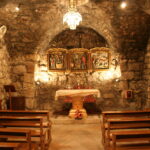- In our last publication, we focused on why history matters. Given its relevance, our attention now shifts to the centrality of the preservation of history. The idea of preservation begins with a deeper appreciation of the concept of sacred memory. This idea encompasses the remembrance and recollection of revered and significant signs and symbols that evoke spiritual heritage and divine connection. This includes recollection of stories, events, places, persons and even artefacts that strengthen faith and communal identity with Christianity. Sacred memory is the nexus and bridge between the past and the present in Christianity. Sacred memory forms the infrastructure of most faith. Any religion that does not preserve the memory and elements of its faith is steeped in self-immolation. Memory is vital for faith.
- The history of Christianity is grounded in sacred memory. In the Old Testament, Moses instructed the people repeatedly: “You shall remember all the way which the Lord your God has led you…” (Cf. Deut. 8:2, 4, 14, 16). In the New Testament, Jesus, in founding the Eucharist, grounded it again on memory, saying, “Do this in memory of me” (Cf. Matt. 26:26, Mark 14:22, Luke 22:19, and 1 Cor. 11:24-25). Both in the Old and New Testaments, the building of the faith was grounded on the invitation to preserve sacred memory. The reason for the preservation of memory is to sustain our connection to a solid past. Without memory, we are both disconnected from the past and alienated from a source. Hence, the Church privileges the task of preserving memory. Pope Francis says: “Memory is not something private; it is the path that unites us to God and others. This is why in the Bible, the memory of the Lord must be passed on from generation to generation.” (Homily of His Holiness, Pope Francis, on the Solemnity of the Most Body and Blood of Christ, 14 June, 2020). The idea of sacred memory leaves a challenge: preservation and transmission. The notion of transmission is what has kept the continuum of faith and tradition in Christianity.
- But what if what is transmitted is corrupted? What if what we have witnessed and seen is not transmitted correctly? If memory transmission is left to oral communication, it can be susceptible to corruption. Hence, there is a need for memory preservation. The sanctity of sacred memory preservation is the fundamentum of holy tradition. Memory is tied to faith in an inextricable manner. Our responsibility is to preserve the memory of the Church. The ability to protect church memory or ecclesiastical history involves the perpetuation of the faith. In contrast, not to preserve church memory will be an attempt to disconnect future generations from a rich past. The task of the preservation of ecclesiastical history requires precision and intentionality. This means undertaking efforts that would protect history from corruption, and this begins with an engagement of purpose. If we do not set out with a purpose to transmit the faith, we will not adopt means that will keep the records precise.
- The preservation of ecclesiastical history is a sacred duty, just as the propagation or handing on of the faith is a sacred duty and challenge. The former is vital for the latter. If what is transmitted is not kept correctly, then the sanctity and purity of what is transmitted will not be guaranteed. Hence, pastors are not just cura animarum (pastors of souls), but also custos fidei (custodian of the faith), and custos historiae (custodian of history). Faith and history are closely linked. Just as God is revealed through history, faith is preserved through history. History offers a crucial context for understanding faith and the Christian tradition. Hence, pastors must be the custodians of history and not its destroyers.
- Being the custodians of history involves acute attention to preserving ecclesiastical patrimony. The Apostolic Constitution, Pastor Bonus, Pope John Paul II, says: “to this patrimony belong, in the first place, all works of every kind of art of the past, works that must be kept and preserved with the greatest care. Those works whose proper use has ceased are to be kept properly in museums of the Church or elsewhere” (Art 100). The sense this evokes is that elements, works and arts of the faith are not to be destroyed and thrown away but preserved in museums, whether they are relevant to the present time. There is a rising throwaway culture which seems to discard anything that is not in vogue. Faith is not about what is vogue or cultural trends, but more about establishing a relationship with Christ, and history does this well. Hence, there is always a need to preserve things that keep us connected to our faith journey. Put it clearly, if, for instance, a chalice no longer befits the liturgy, instead of throwing it away, it can be preserved to show how the church has evolved, and it could be used to inspire faith in the future from the past. In another token, if, for instance, a pastor goes to evangelise a community that was fetish or pagan and found the elements of their pagan worship, rather than burn and destroy them, it would be good to preserve them in a museum to show how the people were evangelised and purified or what they served before they were converted. The burning of such items can truncate a particular faith journey or experience.
- Other historical objects that must be preserved also include “all documents and materials referring and testifying to pastoral life and care, as well as to the rights and obligations of dioceses, parishes, churches and other juridical persons in the Church” (Bonus Pastor, Art. 101 §1). This token implies that record-keeping and pastoral journaling are a pastoral prerogative. Records of all letters, receipts, events and activities are to be neatly kept. They form part of the faith journal in a parish or any ecclesiastical institution. When important events are celebrated, their records should be kept. This duty implies the keeping of all the documents, including sacramental records, minutes of pastoral council meetings, report of society, annual report of parishes and so on. These records can show how the faith journey is lived and help its subsequent appreciation. Programs and brochures of events should be kept to show memorable events that have been celebrated in the faith journey. In the events of church celebrations, faith history can be constructed from first-hand sources and not merely from personal speculations.
- Historical patrimonies should be kept in archives, libraries or museums, and every ecclesiastical institution should have these. Devotion should also be paid to writing biographies and records of holy and great people who have equally impacted the faith journey of a Christian community. While digital documents can be kept, there should be physical duplicates. Historical preservation also includes protecting and restoring buildings. The temptation of “Pull-it-down” and “throw-it-away” must be resisted by all means for the sake of historical preservation and the perpetuation of the faith. We must keep solemn the responsibility to hand on to future generations what we inherited and taught about the faith.





